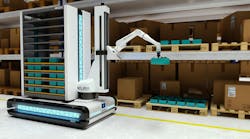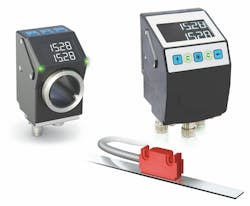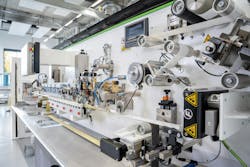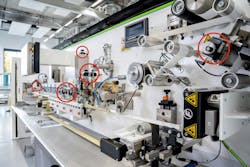Large tubes, small tubes, long tubes, thick tubes, flat tubes, miniature tubes—tubes are produced in countless sizes and formats for oral care, cosmetics, and the pharmaceutical industry.
PackSys Global is responsible for the machines that produce packaging for toothpaste and cosmetic products. With a focus on efficiency, high output, and ease of use, PackSys streamlines its processes with digitization and automation.
An important part of keeping its machines and process reliable is ensuring that the machines properly changeover, specifically being able to change settings to adapt to different types of tube formats. To do so, PackSys has integrated a solution from SIKO GmbH that monitors changeover and increases the ease of operation of its tube welding machines while making adjustments of the different units safer.
Monitored Changeover in New Tube Welding Machine
Many of the company’s machines require regular changeovers. The most common method is to use mechanical position indicators that are manually set to a stored position value outlined in documentation. However, this has a high potential for error as values can easily be read and set incorrectly. When you add in frequent adjustments for multiple types of product, the change to digital position indicators is a worthwhile alternative.
The company tested digital position indicators during the development of a new tube welding machine, the FlexSeamer.
The digital AP05 position indicator with IO-Link interface from SIKO was chosen for its compact size, its ability to be applied vertically or horizontally, and its easy readability due to two LED lights.
The displays are used at ~10 positions throughout the system to check settings like the thickness, the length of the plastic laminates, or a varying print image.
Another SIKO position indicator, the AP10S, is used to monitor the positioning during linear movements.
From Laminate to Tube
The FlexSeamer is used to unwind a flat belt material—a plastic laminate—from a large roll of material. Depending on the product requirements, the plastics processed are usually material blends that have good barrier properties to minimize the amount of oxygen reaching the product inside and limit the diffusion of aromatic substances out of the tube.
The plastic sheet is folded lengthwise, formed into a tube, and then provided with a longitudinal weld seam, transforming the flat material into an endless tube. The plastic tube is cut into individual sections by a rotary blade. This is the actual body of the tube into which the cosmetic, toothpaste, or pharmaceutical product will later be filled.
In a subsequent machine, known as the “Header & Capper,” a so-called shoulder with threaded and capped ends is placed on one of the two sides. The other side is left open so that the contents can be inserted through this opening during the filling process and a final transverse weld seam can be applied.
FlexSeamer: High Speed and Reliable Operation
The new welding machine features a speed of 250 tubes per minute, long heating and cooling sections designed for modern laminate types, and fast and reliable operation thanks to its digital settings.
While mechanical position indicators only display the actual value of a position, digital position indicators also show the target value of a setting. For example, the dimensions for a particular type of tube are stored as a recipe in the machine control system and are then transferred to the respective indicators via IO-Link. An operator then adjusts the setting to match the actual and target values. This is the only way to continue with the production process. Reliable indicators here include the two LED lights, which illuminate green only when the values match. As long as a red light remains illuminated on the system, the process must be stopped and readjusted.
“It is often only when products are subjected to random destructive testing, which requires a great deal of effort, that the effects of an incorrect setting become apparent. However, if the digital position indicators ensure that the same settings are used throughout the production process, there is no need for downstream quality control. This is a significant added value of monitored changeovers," said Emanuel Heusser, Group Manager Automation Engineering in R&D.
“Magic Fingers” Are Becoming More Rare
Increasingly, digitized solutions are providing support even in times of skilled labor shortages, says Aitor Henao. “Years ago, there was one skilled worker, who had been with the company for 20 or 30 years, that knew exactly where to make adjustments based on experience, and had 'magic fingers' when a setting no longer worked perfectly. However, today we have a very flexible labor market where skilled workers are rare. Intuitive operation that enables process-safe settings without in-depth knowledge of the machine helps companies address the shortage of skilled labor.”
There are many factors to consider when deciding on a monitored changeover. Positions requiring frequent adjustments are ideal for this type of investment in digital monitoring. Another argument can be the costly downtime associated with format changeovers.
For rare adjustments or situations where incorrect settings are immediately noticeable, PackSys Global continues to use mechanical position indicators from SIKO since they allow for easily controlled position values. Another option from SIKO’s range of solutions is compact, fully automatic positioning drives which allow size adjustment at the touch of a button. They're also easy to use in hard-to-reach areas of a machine.
Example Settings for Print Mark Sensors
An additional benefit of monitored changeover can be illustrated using an example of the print mark sensor:
To cut the tube section, the cut must be made in the correct position relative to the print image. This is done by applying printed marks to the laminate, which are detected by sensors. The mark is located in a different place on the circumference of the tube depending on the print image. Therefore, the position of the sensor on the circumference must always be slightly different to detect this print mark.
The position of the print mark sensor can now be recorded in degrees and stored in the recipe thanks to the AP10S position indicator. This means that the operator doesn't have to go into the machine to position the sensor relative to the print mark. Instead, the target positioning values are stored for each print image.
For rare adjustments or situations where incorrect settings are immediately noticeable, PackSys Global continues to use mechanical position indicators from SIKO since they allow for easily controlled position values. Another option from SIKO’s range of solutions is compact, fully automatic positioning drives which allow size adjustment at the touch of a button. They're also easy to use in hard-to-reach areas of a machine.
Example Settings for Print Mark Sensors
An additional benefit of monitored changeover can be illustrated using an example of the print mark sensor:
To cut the tube section, the cut must be made in the correct position relative to the print image. This is done by applying printed marks to the laminate, which are detected by sensors. The mark is located in a different place on the circumference of the tube depending on the print image. Therefore, the position of the sensor on the circumference must always be slightly different to detect this print mark.
The position of the print mark sensor can now be recorded in degrees and stored in the recipe thanks to the AP10S position indicator. This means that the operator doesn't have to go into the machine to position the sensor relative to the print mark. Instead, the target positioning values are stored for each print image.
Integration of the SIKO Position Indicators
For Emanuel Heusser, the universal applicability of the AP05 on both vertical and horizontal axes was a major plus. “The display is angled at 45 degrees and can be configured via the software in regard to how it should be positioned. This also makes it easier for us to stock different products for vertical and horizontal axes. The actual integration proved to be straightforward, both regarding the mechanical design and the electronic integration.
There has always been a great deal of goodwill. SIKO aims to make wishes and suggestions a reality. For example, the AP05 was specially designed with IO-Link for our FlexSeamer project.”
Looking ahead, Aitor Henao sees a clear trend toward digitization and automation of systems, especially in the area of changeovers. “These small details, such as the LED display, make all the difference. They improve the quality of our machines and services, helping customer companies to focus on their business.”














